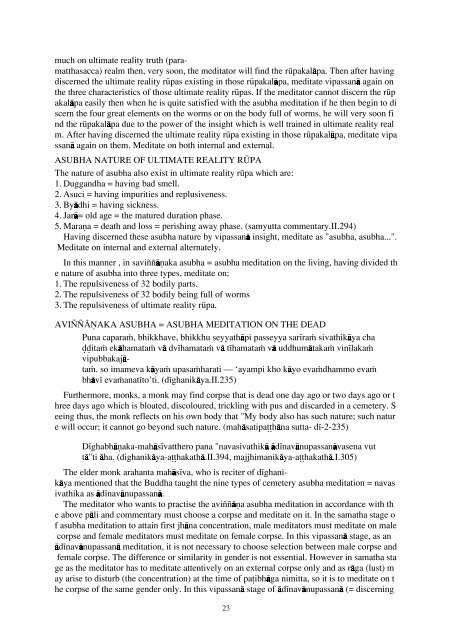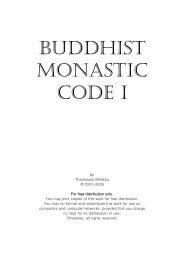Vipassana Kammatthana.pdf
Vipassana Kammatthana.pdf
Vipassana Kammatthana.pdf
Create successful ePaper yourself
Turn your PDF publications into a flip-book with our unique Google optimized e-Paper software.
much on ultimate reality truth (paramatthasacca)<br />
realm then, very soon, the meditator will find the rËpakalåpa. Then after having<br />
discerned the ultimate reality rËpas existing in those rËpakalåpa, meditate vipassanå again on<br />
the three characteristics of those ultimate reality rËpas. If the meditator cannot discern the rËp<br />
akalåpa easily then when he is quite satisfied with the asubha meditation if he then begin to di<br />
scern the four great elements on the worms or on the body full of worms, he will very soon fi<br />
nd the rËpakalåpa due to the power of the insight which is well trained in ultimate reality real<br />
m. After having discerned the ultimate reality rËpa existing in those rËpakalåpa, meditate vipa<br />
ssanå again on them. Meditate on both internal and external.<br />
ASUBHA NATURE OF ULTIMATE REALITY RÚPA<br />
The nature of asubha also exist in ultimate reality rËpa which are:<br />
1. Duggandha = having bad smell.<br />
2. Asuci = having impurities and replusiveness.<br />
3. Byådhi = having sickness.<br />
4. Jarå= old age = the matured duration phase.<br />
5. Maraˆa = death and loss = perishing away phase. (samyutta commentary.II.294)<br />
Having discerned these asubha nature by vipassanå insight, meditate as "asubha, asubha...".<br />
Meditate on internal and external alternately.<br />
In this manner , in saviññåˆaka asubha = asubha meditation on the living, having divided th<br />
e nature of asubha into three types, meditate on;<br />
1. The repulsiveness of 32 bodily parts.<br />
2. The repulsiveness of 32 bodily being full of worms<br />
3. The repulsiveness of ultimate reality rËpa.<br />
AVIÑÑÓÔAKA ASUBHA = ASUBHA MEDITATION ON THE DEAD<br />
Puna capara◊, bhikkhave, bhikkhu seyyathåpi passeyya sar¥ra◊ sivathikåya cha<br />
∂∂ita◊ ekåhamata◊ vå dv¥hamata◊ vå t¥hamata◊ vå uddhumåtaka◊ vin¥laka◊<br />
vipubbakajåta◊.<br />
so imameva kåya◊ upasa◊harati — ‘ayampi kho kåyo eva◊dhammo eva◊<br />
bhåv¥ eva◊anat¥to’ti. (d¥ghanikåya.II.235)<br />
Furthermore, monks, a monk may find corpse that is dead one day ago or two days ago or t<br />
hree days ago which is bloated, discoloured, trickling with pus and discarded in a cemetery. S<br />
eeing thus, the monk reflects on his own body that "My body also has such nature; such natur<br />
e will occur; it cannot go beyond such nature. (mahåsatipa håna sutta- d¥-2-235)<br />
D¥ghabhåˆaka-mahås¥vatthero pana "navasivathikå åd¥navånupassanåvasena vut<br />
tå"ti åha. (dighanikåya-a hakathå.II.394, majjhimanikåya-a hakathå.I.305)<br />
The elder monk arahanta mahås¥va, who is reciter of d¥ghanikåya<br />
mentioned that the Buddha taught the nine types of cemetery asubha meditation = navas<br />
ivathika as åd¥navånupassanå.<br />
The meditator who wants to practise the aviññåˆa asubha meditation in accordance with th<br />
e above påli and commentary must choose a corpse and meditate on it. In the samatha stage o<br />
f asubha meditation to attain first jhåna concentration, male meditators must meditate on male<br />
corpse and female meditators must meditate on female corpse. In this vipassanå stage, as an<br />
åd¥navånupassanå meditation, it is not necessary to choose selection between male corpse and<br />
female corpse. The difference or similarity in gender is not essential. However in samatha sta<br />
ge as the meditator has to meditate attentively on an external corpse only and as råga (lust) m<br />
ay arise to disturb (the concentration) at the time of pa ibhåga nimitta, so it is to meditate on t<br />
he corpse of the same gender only. In this vipassanå stage of åd¥navånupassanå (= discerning<br />
23






